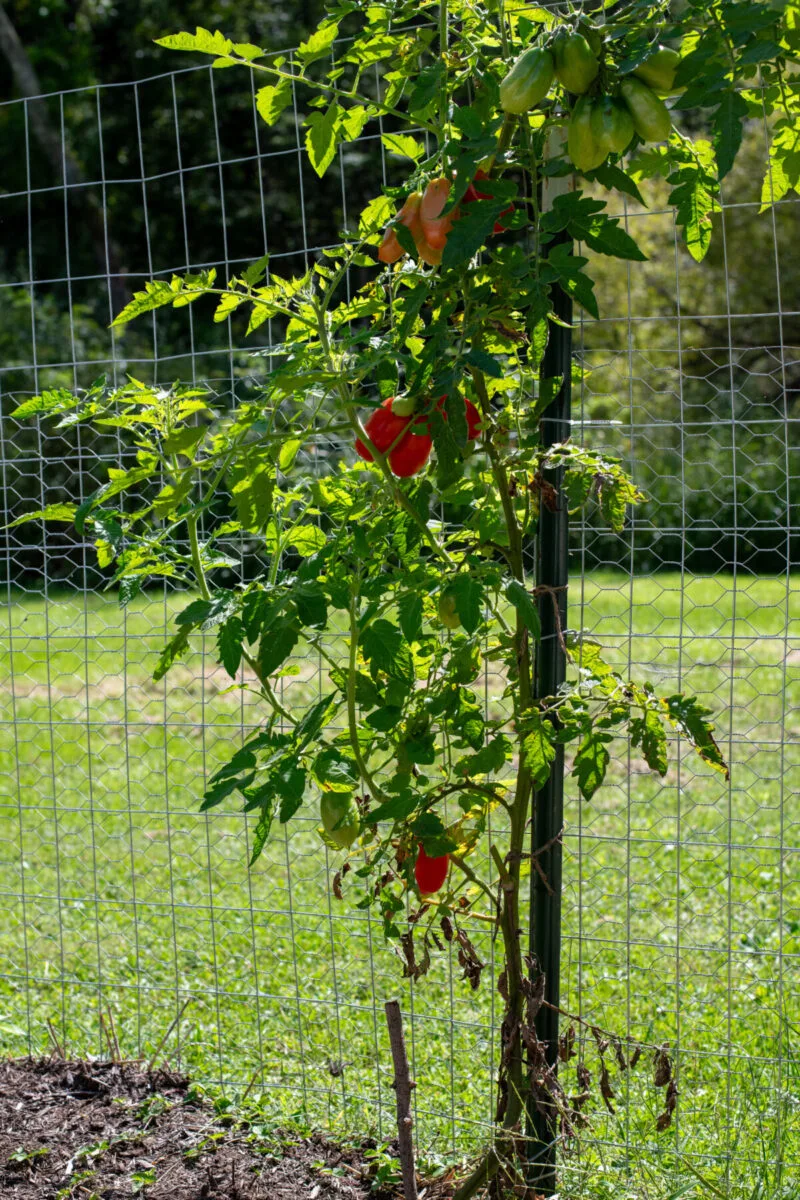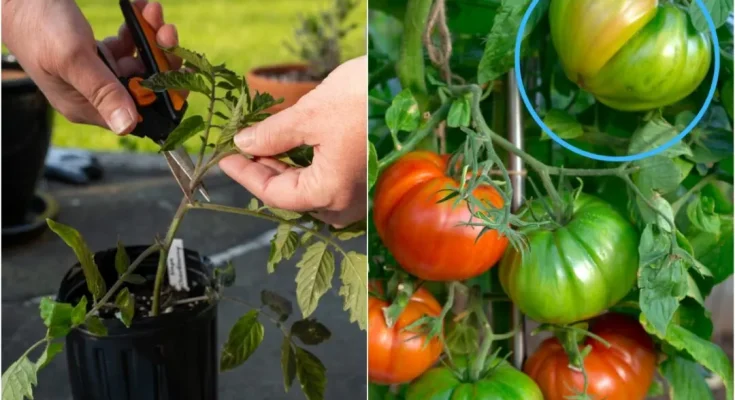When it comes to gardening, there is one harvest you can always count on to be abundant, and that’s advice. Yup, even if you manage to bungle up your garden or Mother Nature does it for you, there will always be a large crop of advice telling you what to do about it and how to fix it.
If you grow tomatoes, then you already know this.
For all the tomato-growing advice floating around out there, you’d think we would have it all figured out by now. But I, for one, still can’t grow the perfect crop of tomatoes, year after year. So, I’m willing to listen to what Joe the Gardener has to say about how he grows his tomatoes. But not when it comes to topping.
There’s a lot of hubbub out there about topping tomatoes and the many “benefits” gained.
Once you understand how vining plants grow, you realize the pros and cons of topping tomatoes is six of one and half a dozen of the other.
What is “Topping” Anyway

Other pruning methods focus on making small cuts from many different areas of the plant. When you top a tomato plant, you’re pinching or cutting off the top of the main stem or leader. This causes significant changes in how the plant will grow after that, but not always in the way we hope.
Knowing this will make it easier for you to determine if the practice of topping tomatoes will work for you.
Indeterminate & Determinate Tomatoes – the difference when it comes to topping
One thing that is clear about topping tomatoes is you shouldn’t do it to determinate varieties. These are tomatoes that have been bred specifically to reach a certain height, between 3-4 feet, and stop growing. They’re often described as bush varieties.
Determinate tomatoes set one flush of fruit all at once. Whereas indeterminate tomatoes will continue to put out new fruit all season long.
Topping determinate tomatoes will decrease your overall yield for that plant, especially if you top more than once.
It makes no sense to top determinate tomato varieties at any time during the growing calendar.
That leaves us with indeterminate varieties, so named because they keep growing throughout the season. As previously mentioned, they continue to put out new fruit right up until the first hard frost kills the plant. By their very nature, you’ll end up with some green tomatoes that won’t ripen by the end of the growing season.

Indeterminate tomatoes grow from a main leader. This main stem will continue to grow in length, putting out new fruit and side shoots all season long. These side shoots are called suckers, and there’s a whole lot of gardening advice about those as well. (Suckers have an unearned bad reputation. When managed correctly, they will also produce fruit.)

Because of this growth pattern, it’s mostly indeterminate tomatoes that end up getting topped. There are a handful of reasons given for topping tomatoes, but are they worth it? Depending on how you grow your tomatoes or what you’re hoping to accomplish, it may not be the case.
Let’s pick apart the most common reasons for topping tomatoes. Then you can decide if this practice is worth the bother in the end.
Top Seedlings to Encourage Bushier Plants

One thing I see suggested early on in the growing season is to top tomato seedlings to encourage bushier growth through lateral development. The general idea is to top the main stem of the tomato plant. This in turn forces new main leaders to grow out from the side of the plant.
This is supposed to produce a bushier plant (you now have two main stems rather than one) that will give you more fruit.
Unfortunately, there’s no proof that this actually leads to more fruit. At best, you’re getting roughly the same amount of fruit but from a shorter plant.
The problem with pinching off a portion of your tomato seedling is that it sends a clear signal to the plant that it needs to put out growth elsewhere to make up for it. Where there was once a healthy main stem on its way to producing fruit all on its own, now there’s a wound that needs to heal, and you’ve got to wait while your tomato puts energy into growing lateral side stems.
So, right from the start, you’re delaying fruit set.
Yes, you’ll get bushy plants, but you’ll end up with those anyway as the plant grows. If you’ve ever tried to keep up with pinching off new side shoots as they appear, then you know tomatoes have no problem putting out lateral growth, even with the main stem intact.
Topping tomatoes to get a bushier plant is only worth it if you’re trying to maintain a more compact plant that will grow within the bounds of its support structure. In the end, it won’t get you more fruit.
Not to mention, bushier tomato plants aren’t always a good thing. When it comes to disease-prone tomatoes, airflow is key to a healthy plant, so encouraging dense foliage isn’t necessarily wise.
After all, if you want a compact, bushy tomato, you would be better off growing a determinate variety.
Topping to Promote More Flowers

This one always baffles me – top your tomatoes to force more blossom development. The main stem is already working on it. It’s there growing happily along, all the while putting out new flowers as it gets longer.
The advice for topping to produce more flowers goes something along the lines that by topping the plant, it will redirect the energy that went into growing the main leader into blossom development instead.
Except that’s not how vining plants work.
That main leader was already producing blossoms without draining the plant of excess energy. That’s why the main stems produce new leaves along with blossoms – those new leaves produce the energy the plant needs as it grows.
But if you top the tomato, now it has to put energy into growing a new leader that will eventually bear fruit all over again. You’re slowing the process down by topping that main leader without saving the plant any energy or directing it into flower production.
And, again, as mentioned above, this doesn’t get you more fruit overall; it gets you roughly the same amount of fruit at a slower pace.
Topping Tomatoes to Force Late Fruit to Ripen

Finally, there is the most popular tomato topping advice out there. Indeterminate tomatoes will continue to produce new tomatoes right up until the plant is killed by frost. Naturally, you aren’t going to be able to ripen every tomato that your plant sets before the weather gets too cool.
This is another great reason to grow determinate varieties. Because they set their fruit all at once, you don’t have tons of green tomatoes at the end of the season. Most determinate tomatoes have finished up well before that. Unless, of course, you grow somewhere with a short growing season. If that’s the case, then give one of these short-season tomato varieties a try, or consider starting tomatoes much earlier indoors next year.
This popular piece of advice shows up every fall – top your tomato plants to force them into ripening the rest of the existing fruit.
Again, the general idea is redirecting energy.
The plant no longer has to put energy into growing taller or longer, and it will focus resources on ripening the remaining fruit instead. Unfortunately, this also fails to take into account how vining plants react to being pruned in this way, as well as how tomatoes ripen.
We’ve already discussed how topping a tomato plant isn’t relieving it of putting extra energy into growing taller. You’re redirecting that energy into new leaders, not ripening tomatoes.
The other side to this coin is that getting tomatoes to ripen late in the season has more to do with the temperature than it does with how much energy the plant has.
If the plant can produce a green tomato, it has the energy to ripen it. However, as the days get shorter and the temperatures drop, the necessary chemical reactions that happen inside a tomato slow down or even stop, resulting in green tomatoes that won’t ripen. Even if you top your tomatoes.
Tomatoes ripen when ethylene is produced within the fruit. Yep, that same gas that causes your bananas to ripen too quickly also kickstarts the ripening process. Ethylene causes lycopene synthesis which in turn ripens tomatoes into that red we all know and love.
However, ethylene is only produced within tomatoes at certain temperatures.
Too hot and tomato plants will stop ripening altogether; too cold and the same thing happens. As the fall temperatures drop off, it gets harder and harder for tomatoes to create ethylene to ripen their yield of fruit.
Rather than topping your plants, you can pick any fruit that’s reached the breaker stage (when a tomato starts to blush red) and bring it indoors to a warmer environment where it will finish ripening. You don’t need light to ripen tomatoes, just warm, consistent temperatures.

Topping your tomatoes at the end of the season certainly won’t hurt them, but it won’t have the desired effect of speeding up ripening either. Besides, there’s a lot to love about green tomatoes.
21 Green Tomato Recipes for Using Unripe Tomatoes
By now, you’re probably wondering, “Okay, if I don’t need to top my tomatoes, then how do I deal with a plant that keeps getting longer and longer throughout the growing season?”
How to Grow Tall Tomato Varieties Without Relying on Topping
Heirloom tomatoes are nearly all indeterminate varieties, so if you’re growing heirlooms, you’re looking at long tomatoes. But rather than working against the natural vining habits of indeterminate tomatoes, use that length to grow them vertically. Train tomatoes to grow up a string or espalier them along a fence.

String-training tomatoes is how I grow all of my indeterminate varieties. It puts that aggressive main leader to work, and I enjoy plenty of fruit, too.
Because you’re growing them vertically via the main leader, you can actually grow more tomatoes closer together in your garden. If you want more fruit, skip topping and grow more tomatoes that reach for the sky.



